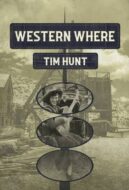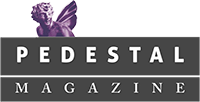 Tim Hunt
Tim Hunt
Western Where
Broadstone Books
Reviewer: Vivian Wagner
Tim Hunt’s poetry collection, Western Where, examines both real and imagined wests, looking for glimmers of truth that lie between western myths. It’s grounded in the realities of the modern west—with its guns and single-wide trailers and diesel trucks—even as it looks backwards and sideways at various western fantasies, dreams, and imaginings.
The collection explores the interaction between seeming opposites, and it often occupies the blurred spaces between words, people, and places. As the opening piece, “Proem: This Too,” says, “[w]e are, the science tells us, / wired to interact ….” The poems in this collection explore the ways that we interact with each other, with past selves, and with the culture around us. At the same time, “here” interacts with “there,” and “now” with “then.” Nothing lives on its own in these poems; everything interacts.
In the collection’s first section, called “1. There & Here,” the poems look at places in the west—primarily eastern California and western Nevada—for what they have to say about both their past and their present. “Still Life: Barbed Wire with Tumbleweeds (Owens Valley, CA),” for example, opens with what was once there and is no more: “There was / water here, / once ….” The water of the region, taken by aqueduct to “… flush the toilets in L.A.”, represents all that the region has lost to modernization and urbanization, with the farmlands along the eastern Sierras drying up and the once-thriving orchards failing. The poem grieves both the change to the landscape and the human loss: “… most of the people moving on— // a few, / left behind ….”
Those people “left behind” are one of the themes of the collection, which looks compassionately at the people of the modern rural west who struggle to survive amidst often ruined economies and landscapes.
“Lone Pine, CA (Western Movies)” introduces another theme threaded through the collection: the stories told by films and TV, and the way these stories both shape and undercut reality. The poem begins with an image of this place as movie set: “Here is where they made the Western movies ….” It also looks at those who watched the movies: “… little boys walked out / into the afternoon light of the real real world ….” The poem looks at the disparities between the movie west and the “real” one, and the way any western landscape can be—and possibly already has been—turned into a backdrop: “Place a shack here, it’s a mining claim.” Yet the poem also throws into question the assumption that the real and the fictional are easily distinguishable; in fact, they might be intractably intertwined, and the little boys watching the films might be just as fictional as the cowboys on the screen.
The collection’s second section, “2. Found & Lost,” looks at another set of seemingly opposite terms and ideas, finding the ways that they slide around and into each other in modern western landscapes. This section of the book is composed of one long poem, “The Fiddle,” which is divided into ten numbered vignettes that feature fiddles of various types and vintages. The poem travels through rural California, accompanied by fiddle tunes and riffs, as well as the improvisational spirit of fiddling. In so doing, it is both rooted in history and floating above it, listening as the musical narrative unfolds. Great-grandfathers teach boys to play fiddle; fiddle cases get passed down to a new generation; and modern country songs pick up the instrument.
In a section of the poem entitled “8. Grange Hall Dance (Middletown, CA, 1935),” the history of dance halls in rural California becomes one way to understand fiddling: “In the Grange Hall, the fiddle’s drone string / keens its forever …,” and the 1930s dance seems to continue into the present: “… the men talking about the things / they talk about, the women / talking about what they talk about ….”
Nothing and everything has changed here since 1935. The poem watches almost as if it’s watching a documentary about the time, and yet it leaves open the possibility that this imagining, too, is a myth. As the speaker says, “… it is easy to believe in this order of things …,” even if this order of things perhaps never exactly existed in the way we might imagine. All of the poem’s vignettes have a hefty dose of skepticism about nostalgia, which can be its own form of a movie, drawing viewers into its spell while obscuring whatever truths might actually exist.
The poem always manages to break out of nostalgia for the past by bringing us directly into an unvarnished present. In its last vignette, for instance, “10. Still Life with Double Wide and Electric Fiddle,” historical fiddling seems at first out of place in the modern western world, with its “… Beamers and Jags, a Cadillac SUV, / the fiberglass gleam of the ski boats— …,” even as it speaks in this world as clearly as it did in all the worlds past. There’s no here vs. there in this poem, only the palimpsest of the present, from which we can start to make sense of the past’s mysterious layers. The speaker says “… to be here is to be lost,” which brings together the here/there, lost/found dichotomies, showing how all along they might have been one and the same.
The collection’s final section, “In this America,” is a Whitman-esque catalog of rural western America, with people who hunt out of hunger and gamble out of fear. The multi-part poem has twenty-one sections, each of which looks at stories and people of the rural west. The last section finds a woman sipping a latté, all dressed up in stiletto boots and designer jeans. We hear she likes the western landscape, but not the people in it: “She doesn’t like you – / your boots work worn, your truck / work worn, you work worn.”
This America, we hear, “… no longer seems yours.” It’s a poem about the clash of cultures—the older west with the modern one, rural landscapes with urban environments, and people in work clothes with those in designer jeans.
Western Where is a fascinating look at the divisions in the modern west between people, cultures, and times. It’s also a survival story—one that holds out the hope that we might, ultimately, bridge those divisions if we look at the project of making sense of the past and the present in terms of rodeo bull-riding. We’ll inevitably be bucked off, but at that point we need to, as the collection’s final poem, “CODA: Rodeo Ride,” says, “… get up / out of the dirt, // look for the clown.”
The poem suggests that maybe it’s the clown who can save us. The clown, perhaps, can throw into question our assumptions, nostalgia, and myth-making, giving us a chance to move out of the way and “ride again” toward whatever future west we might yet create.

